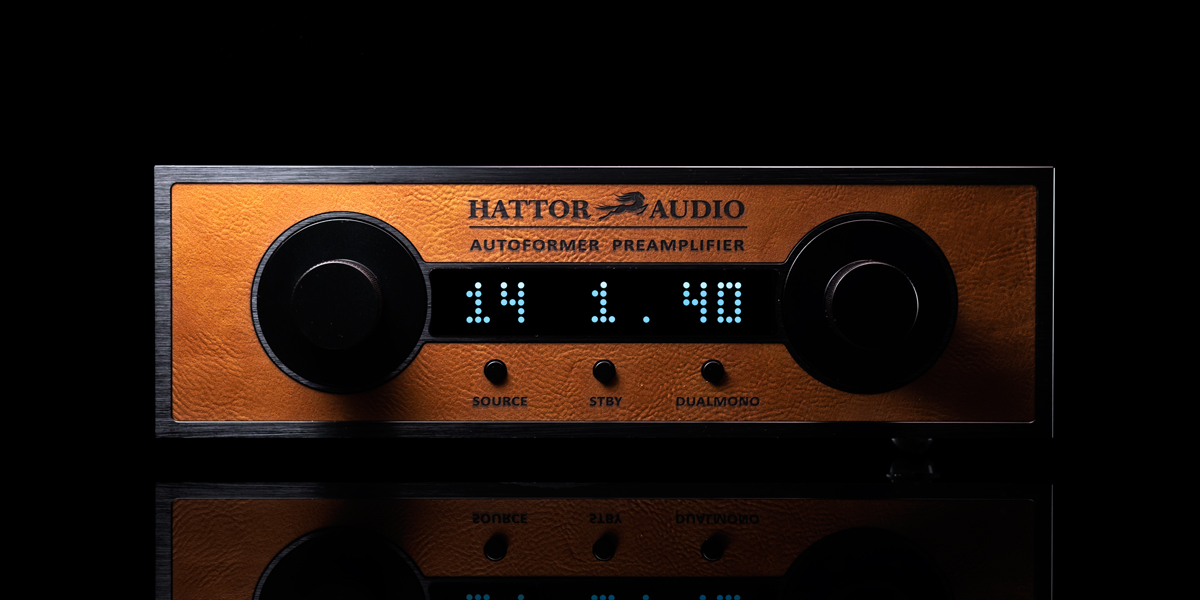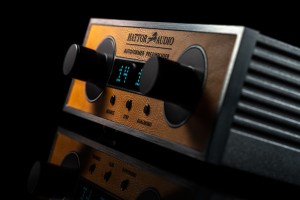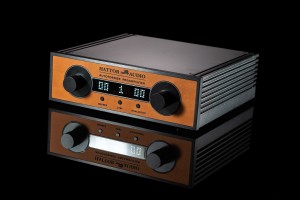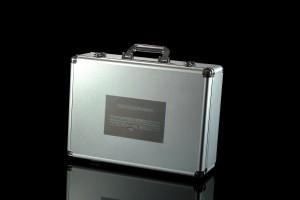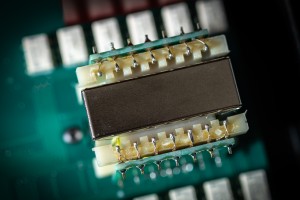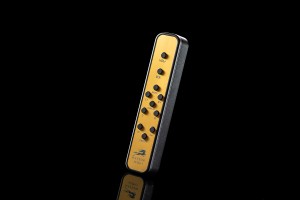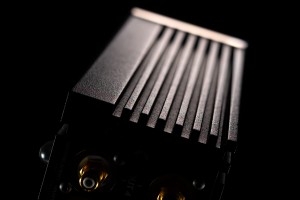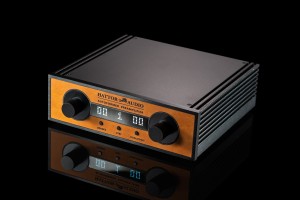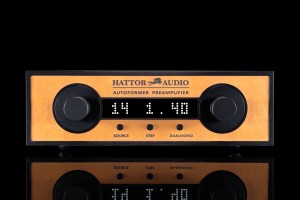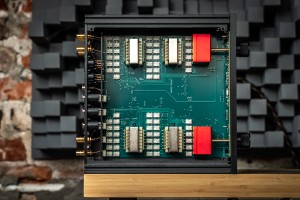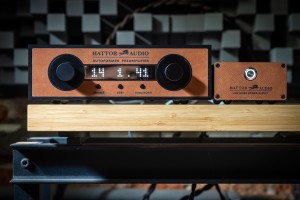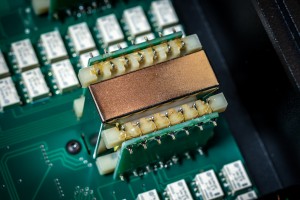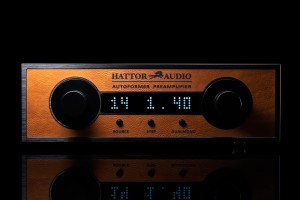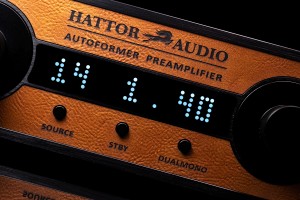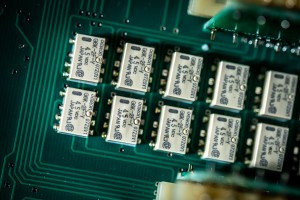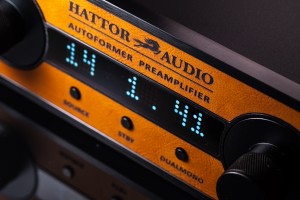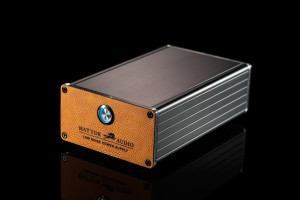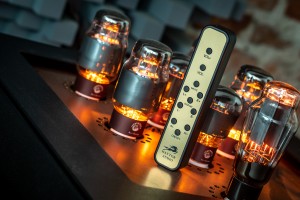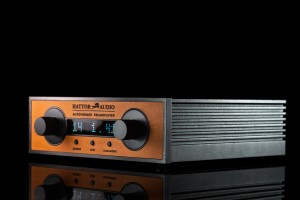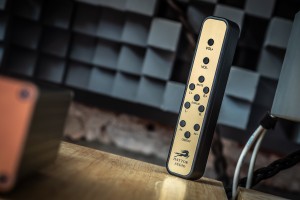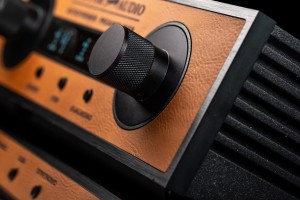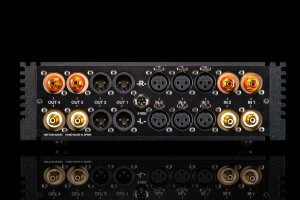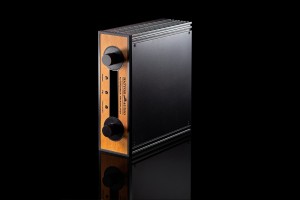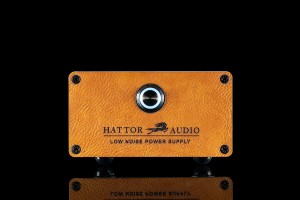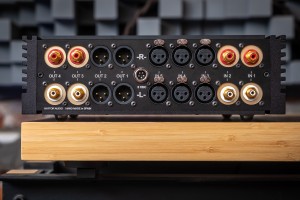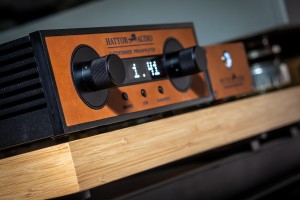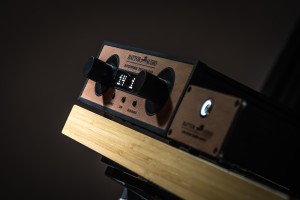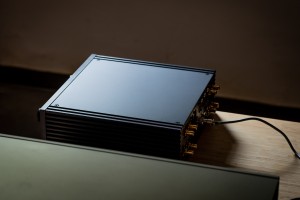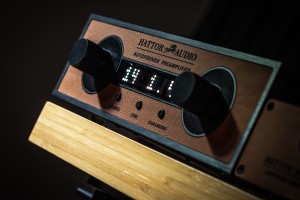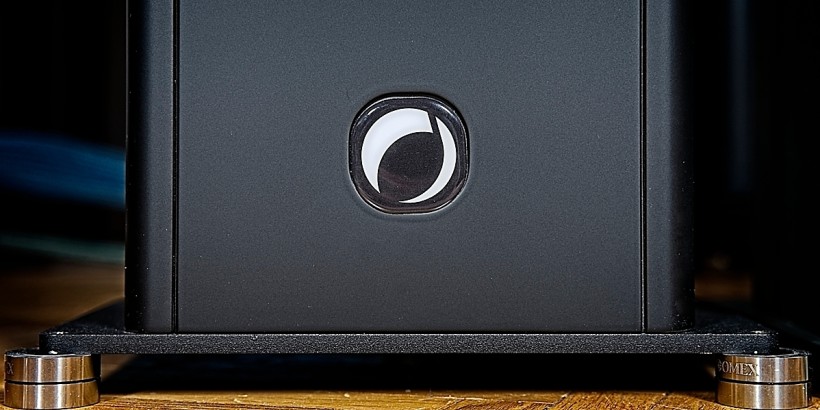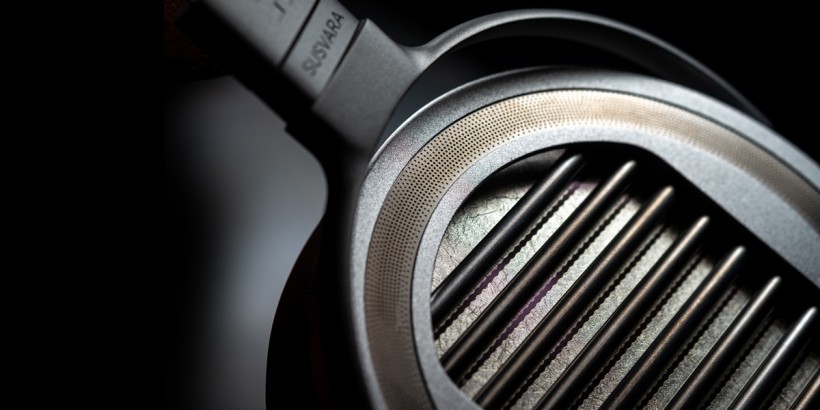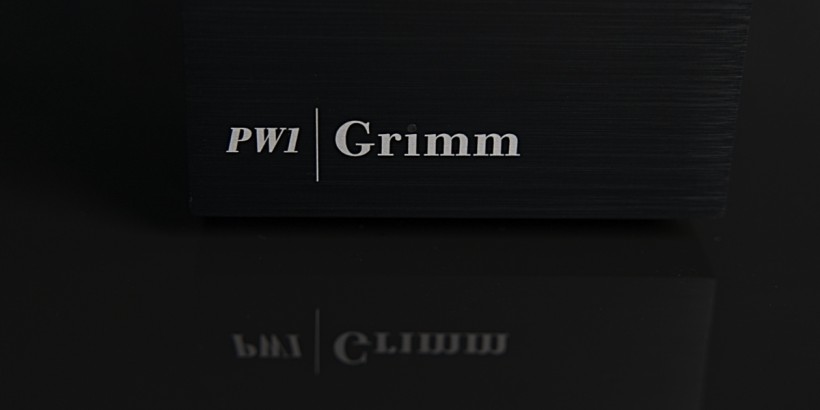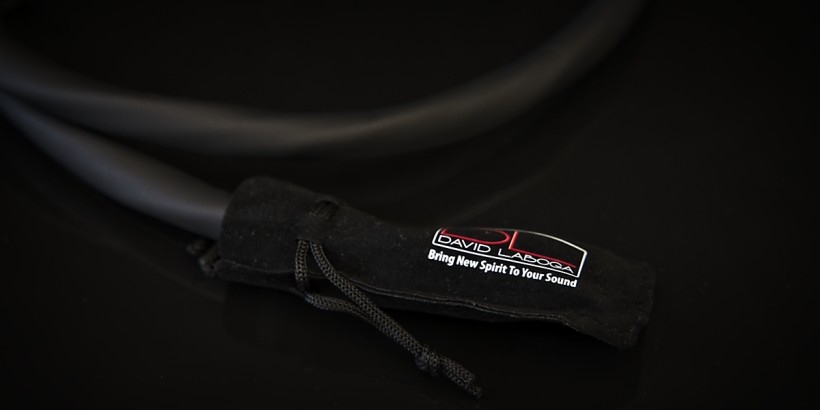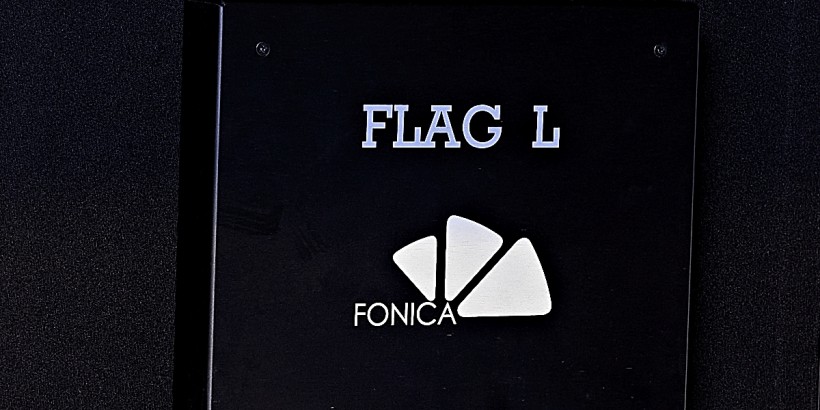Most of the entire preamplifier sector is occupied with active products designed with resistive volume control in mind. At the far smaller passive corner of it, extremely rare AVC devices have carved out their own niche. Hattor Audio ARP is one of them and our subject today. Enjoy!
Wire without gain
Prior to launching this site in early 2016, I had a firm idea how to reasonably quickly grow it into a sustainable daily job. That simple plan involved reaching out to all the local manufacturers I could find, introducing myself and offering them bilingual exposure. Back then the Polish audio biz had around 75 such companies up and running, so a lot of ground to cover. It worked, we’re still around. More importantly, over the years I got in touch i.e. with LampizatOr, Cube Audio, Gigawatt, Stacore, Egg-Shell, Soyaton, JCAT, Audio Phonique, Gemstone and many more. While I enjoy their products and people who make them, Khozmo is that one particularly elusive audio house that’s been on my radar ever since I can remember. In mid 2020 Srajan asked whether I’d heard about the brand Hattor Audio that has the same owner. The name rang a bell, so I reached out to the man in charge of both, Arek Kallas. While he expressed his interest in what I do, his hands were full at that time, so we didn’t move beyond introductory courtesies. Fast forward to early 2025. Arek asked whether I’d be interested in having a go at his latest and, as I was about to learn, very special design. But of course. Recently we met in Warsaw, he left me the goods and the game was afoot.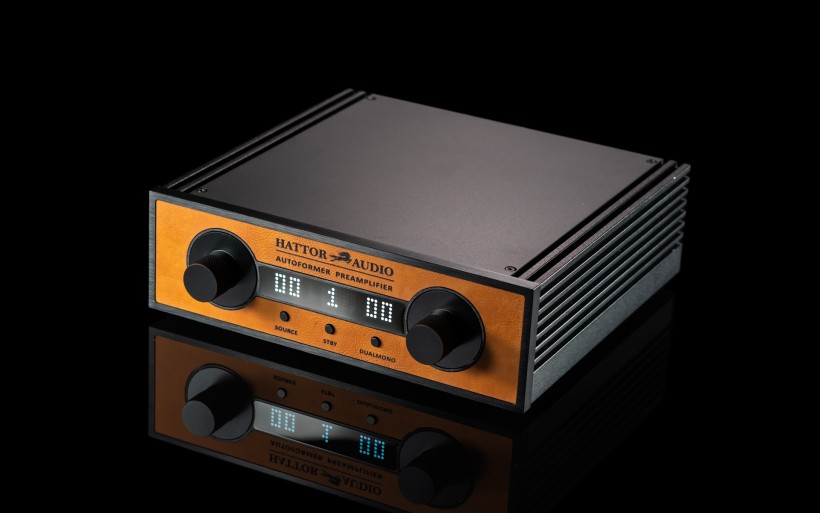 That cargo had me very excited for many reasons and shortly we’ll get to that part. Prior to doing so, let’s first take a look at Arek’s first audio company Khozmo that was established some 15 years ago. While this portfolio features a power amp and quite a few passive preamps including rare TVC types, various attenuators built upon AMRG, AMRT, PRP, Vishay or Z-Foil resistors as mono/balanced/quad devices are its bread and butter. 64-step shunt/ladder attenuation systems with displays, remote control, source selection and opamp-infused active stages follow. This lot clearly winks at DIY-ers who enjoy minting their own stuff around boutique no-compromise volume control schemes. Most importantly, it’s surprising how many top-shelf audio houses use Khozmo components in their own designs. Arek being the OEM supplier for such clients naturally keeps their identity confidential. Suffice it to say, the list of high-caliber brands fond of his services is anything but short. No wonder. The man’s been around for a long time. His designs have the reputation of gorgeously made, extremely reliable and excellent where it matters. In this industry, these are all valid reasons to carve yourself the career of a specialist.
That cargo had me very excited for many reasons and shortly we’ll get to that part. Prior to doing so, let’s first take a look at Arek’s first audio company Khozmo that was established some 15 years ago. While this portfolio features a power amp and quite a few passive preamps including rare TVC types, various attenuators built upon AMRG, AMRT, PRP, Vishay or Z-Foil resistors as mono/balanced/quad devices are its bread and butter. 64-step shunt/ladder attenuation systems with displays, remote control, source selection and opamp-infused active stages follow. This lot clearly winks at DIY-ers who enjoy minting their own stuff around boutique no-compromise volume control schemes. Most importantly, it’s surprising how many top-shelf audio houses use Khozmo components in their own designs. Arek being the OEM supplier for such clients naturally keeps their identity confidential. Suffice it to say, the list of high-caliber brands fond of his services is anything but short. No wonder. The man’s been around for a long time. His designs have the reputation of gorgeously made, extremely reliable and excellent where it matters. In this industry, these are all valid reasons to carve yourself the career of a specialist.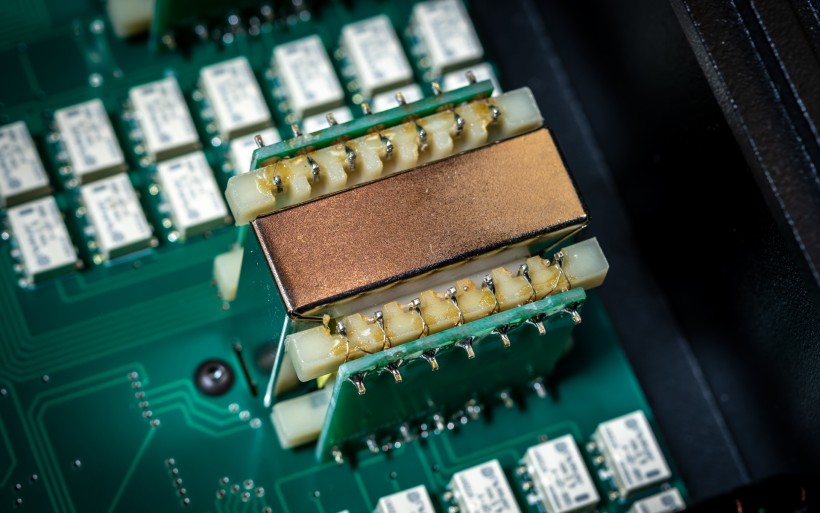 It’s not uncommon for OEM manufacturers to incorporate their tech into hardware for regular consumers and release it under the second brand. In this context, Hattor Audio offers turnkey products with Khozmo stuff in it and then some. The former company has been in the business for about a decade and its current lineup lists six designs; a standalone tubed buffer/gain stage, INT500 integrated amp, MINI/Ultimate stereo/mono power amps and MINI/The BIG preamps available either as passive or active affairs. Adorable compactness, price to sell and handsome heavily customizable exterior are the common ground for all this lot. During our chat Arek explained that he enjoys making products that sound good and offer great bang for your buck. He meant it. For example, his most affordable passive MINI preamp packed with the already posh 64-step Vishay-based attenuator, remote wand, custom-made heat sinks and 3x/2x inputs/outputs wants €900. Silver/black color options selectable for chassis, knobs and front panel (the outline and internal piece, the latter also in wood) are included in the price. Should you find that sticker suspiciously low, fret not. The fully kitted MINI pre that rocks top-shelf Amtrans AMRG resistors and active stage with Staccato op-amps in it retails for €2’400.
It’s not uncommon for OEM manufacturers to incorporate their tech into hardware for regular consumers and release it under the second brand. In this context, Hattor Audio offers turnkey products with Khozmo stuff in it and then some. The former company has been in the business for about a decade and its current lineup lists six designs; a standalone tubed buffer/gain stage, INT500 integrated amp, MINI/Ultimate stereo/mono power amps and MINI/The BIG preamps available either as passive or active affairs. Adorable compactness, price to sell and handsome heavily customizable exterior are the common ground for all this lot. During our chat Arek explained that he enjoys making products that sound good and offer great bang for your buck. He meant it. For example, his most affordable passive MINI preamp packed with the already posh 64-step Vishay-based attenuator, remote wand, custom-made heat sinks and 3x/2x inputs/outputs wants €900. Silver/black color options selectable for chassis, knobs and front panel (the outline and internal piece, the latter also in wood) are included in the price. Should you find that sticker suspiciously low, fret not. The fully kitted MINI pre that rocks top-shelf Amtrans AMRG resistors and active stage with Staccato op-amps in it retails for €2’400. 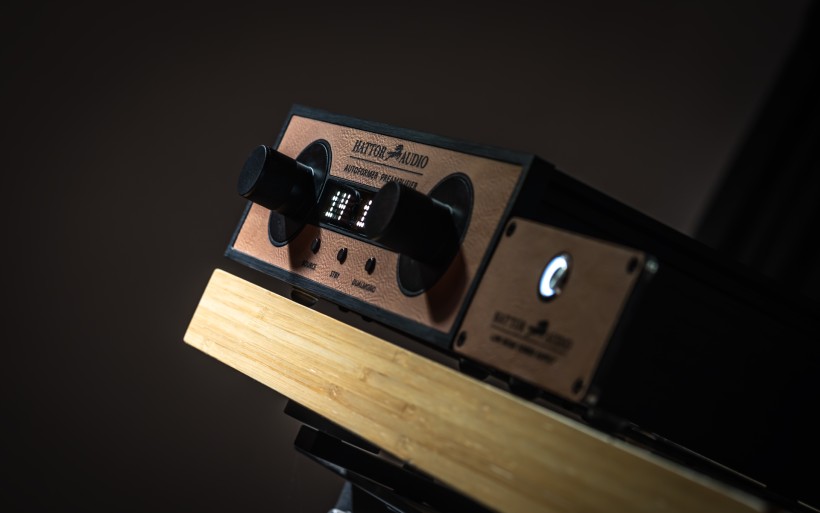 Although Hattor Audio The BIG is the company’s current flgship preamp built in the dual mono fashion, it starts from €900 just like the MINI. In that price we get RCA i/o, remote control, Vishay attenuation ladder, external linear PSU (!!!) and passive MO. The available color variants for individual chassis bits remain as specified above. The forehead however can now feature either a carbon fiber or leather insert at no extra cost. AMRT/AMRG/Z-Foil resistors add €500/600/1’000 to the bill respectively. XLR i/o raises it by €100/400/500/600 with Vishays/AMRT/AMRG/Z-Foils. Should we want to go active, OPA2134/Staccato op-amp circuits eat up another €450/600. The BIG in its dearest form and resistive volume retails for €3’200. While this is serious money in the Hattor lineup, the non-resistive autoformer volume control aka AVC determines the financial ceiling and is the key plot twist this time around. Today’s newcomer Autoformer Reference Preamplifier aka ARP shares its exterior with The BIG, so naturally allows for the same custom finishes. With RCA/XLR i/o and copper-wound autoformers it sells for €2‘500/3’500, while silver windings for them raise the sum total to €4‘500/6’900 respectively. Active op-amp stages defeat the design’s purist passive purpose, so understandably are unavailable for the ARP. My loaner had copper AVCs mainly because the silver version wasn’t yet ready. No matter. These rarely used transformers promise an awful lot on sonics either way. They also are the very reason why I was so excited about this report’s exotic arrival
Although Hattor Audio The BIG is the company’s current flgship preamp built in the dual mono fashion, it starts from €900 just like the MINI. In that price we get RCA i/o, remote control, Vishay attenuation ladder, external linear PSU (!!!) and passive MO. The available color variants for individual chassis bits remain as specified above. The forehead however can now feature either a carbon fiber or leather insert at no extra cost. AMRT/AMRG/Z-Foil resistors add €500/600/1’000 to the bill respectively. XLR i/o raises it by €100/400/500/600 with Vishays/AMRT/AMRG/Z-Foils. Should we want to go active, OPA2134/Staccato op-amp circuits eat up another €450/600. The BIG in its dearest form and resistive volume retails for €3’200. While this is serious money in the Hattor lineup, the non-resistive autoformer volume control aka AVC determines the financial ceiling and is the key plot twist this time around. Today’s newcomer Autoformer Reference Preamplifier aka ARP shares its exterior with The BIG, so naturally allows for the same custom finishes. With RCA/XLR i/o and copper-wound autoformers it sells for €2‘500/3’500, while silver windings for them raise the sum total to €4‘500/6’900 respectively. Active op-amp stages defeat the design’s purist passive purpose, so understandably are unavailable for the ARP. My loaner had copper AVCs mainly because the silver version wasn’t yet ready. No matter. These rarely used transformers promise an awful lot on sonics either way. They also are the very reason why I was so excited about this report’s exotic arrival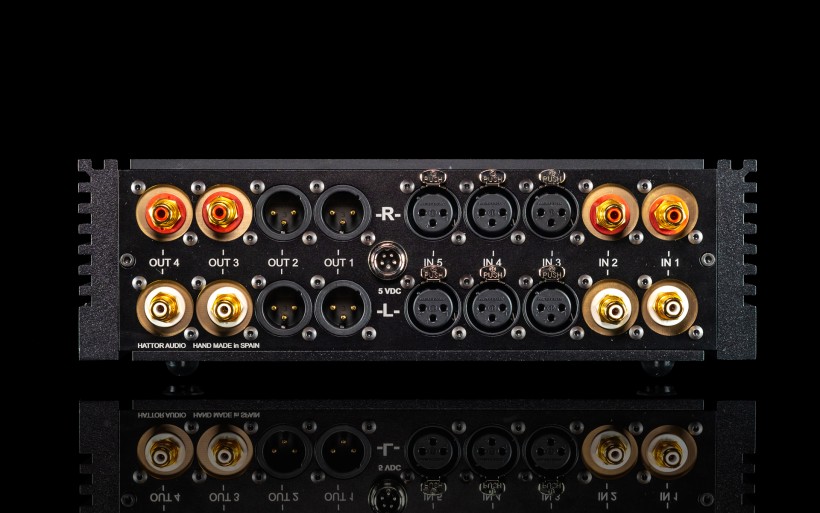 Let’s talk basics as explained here. To recap, an active preamp packs an input selector, attenuator, powered thus active gain stage that amplifies line-level signal from a source above its original voltage, and an output buffer to isolate i/o and keep output Ω low. Meanwhile, passive preamps feature only a source selector and attenuator that trims the input signal to the desired volume, and that’s it. This means that their kind cuts signal without boosting. These days that’s not a problem. Most modern sources output signal sufficent to drive most amps to their fullest without the extra gain in-between. Simply put, passive preamps achieve the same fundamental goal as their active siblings, just with fewer means and effectively far simpler design. The latter can take the form of expensive internally elaborate affairs busy with transistors, tubes, op-amps, output transformers, boutique caps, power supplies and so on so forth. All these parts contribute with their own sonic flavor. The passive breed is free from any such means and considered among enthusiasts as highly transparent because of that. The minimalism baked into this topology is in fact the main attractor for those who understand that, in this hobby, less is more and simplicity is king. Should we want a preamp with gain to spare and audible personality, actives fit that profile. If we desire a voiceless signal divider in a compact box, passives are the ticket. They’re not all alike, however. To execute signal attenuation, such designs utilize resistive stepped attenuators, and non-resistive magnetic/inductive multi-tapped transformers (TVCs) and autoformers (AVCs). The designer’s choice between these essential components is what makes all the difference.
Let’s talk basics as explained here. To recap, an active preamp packs an input selector, attenuator, powered thus active gain stage that amplifies line-level signal from a source above its original voltage, and an output buffer to isolate i/o and keep output Ω low. Meanwhile, passive preamps feature only a source selector and attenuator that trims the input signal to the desired volume, and that’s it. This means that their kind cuts signal without boosting. These days that’s not a problem. Most modern sources output signal sufficent to drive most amps to their fullest without the extra gain in-between. Simply put, passive preamps achieve the same fundamental goal as their active siblings, just with fewer means and effectively far simpler design. The latter can take the form of expensive internally elaborate affairs busy with transistors, tubes, op-amps, output transformers, boutique caps, power supplies and so on so forth. All these parts contribute with their own sonic flavor. The passive breed is free from any such means and considered among enthusiasts as highly transparent because of that. The minimalism baked into this topology is in fact the main attractor for those who understand that, in this hobby, less is more and simplicity is king. Should we want a preamp with gain to spare and audible personality, actives fit that profile. If we desire a voiceless signal divider in a compact box, passives are the ticket. They’re not all alike, however. To execute signal attenuation, such designs utilize resistive stepped attenuators, and non-resistive magnetic/inductive multi-tapped transformers (TVCs) and autoformers (AVCs). The designer’s choice between these essential components is what makes all the difference. 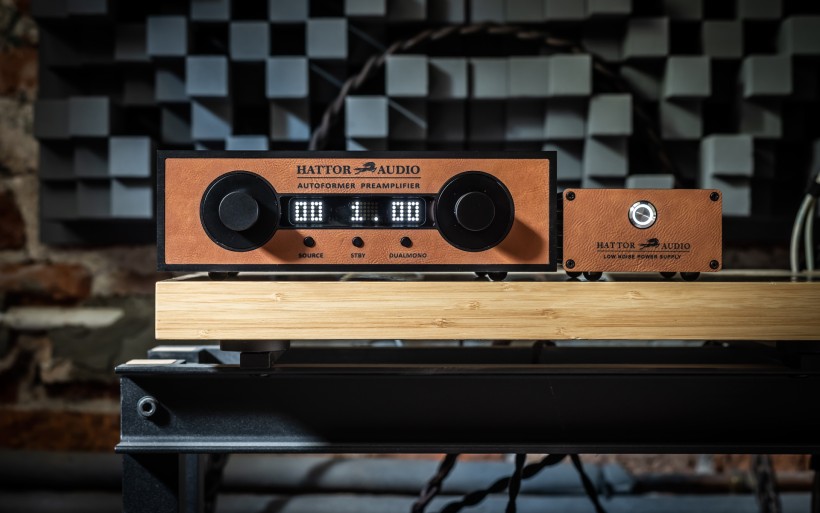 To transfer electrical energy, a transformer uses two magnetically coupled and electrically isolated coils aka primaries and secondaries. An autoformer has a single winding, with parts of it acting as both primary and secondary coils, here connected magnetically and electrically. The latter transformer type features wider bandwidth, lower ringing, simpler construction and significantly less wire to do the same job. Autoformers also are far superior over resistive attenuators as far i/o impedance matching and related hardware compliance are concerned. No galvanic isolation between their inputs and outputs is the only real con, but all the benefits make them more than fit for the task in discussion. It’s accurate that autoformers provide non-resistive volume control over a wire with multiple taps selected by relays. It doesn’t get any simpler and more elegant than this. This is why audience familiar with autoformers consider them highly desirble. They’re also extremely rare.
To transfer electrical energy, a transformer uses two magnetically coupled and electrically isolated coils aka primaries and secondaries. An autoformer has a single winding, with parts of it acting as both primary and secondary coils, here connected magnetically and electrically. The latter transformer type features wider bandwidth, lower ringing, simpler construction and significantly less wire to do the same job. Autoformers also are far superior over resistive attenuators as far i/o impedance matching and related hardware compliance are concerned. No galvanic isolation between their inputs and outputs is the only real con, but all the benefits make them more than fit for the task in discussion. It’s accurate that autoformers provide non-resistive volume control over a wire with multiple taps selected by relays. It doesn’t get any simpler and more elegant than this. This is why audience familiar with autoformers consider them highly desirble. They’re also extremely rare.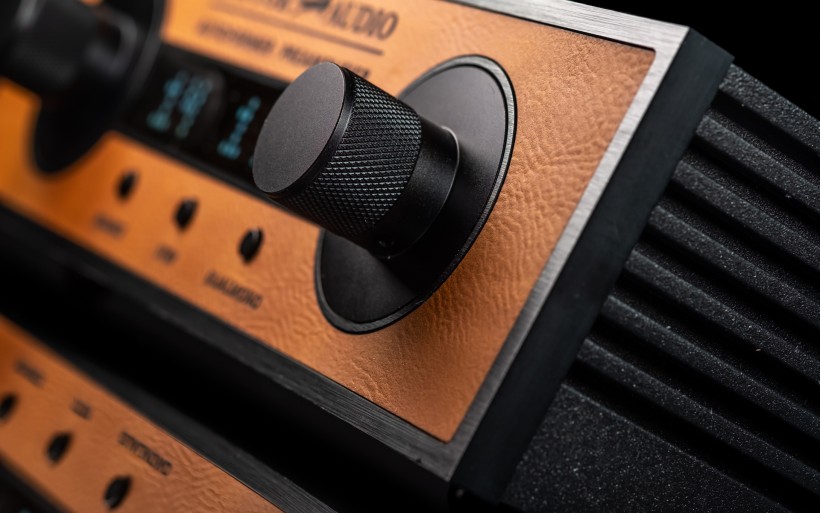 The box from Arek stored a very nice flight case with the brand logo on it. The foamy interior housed the key ingredient, a linear PSU for it, a short gray umbilical cord to connect them, and a handy high-quality aluminium RC wand. All in all, this was one luxo set. Far dearer products very rarely come as kits this fine, let alone devices in today’s financial ballpark. In fact, I haven’t seen any that would come any close to the ARP on that particular front. Kudos to Arek for going all the extra miles. Just so we’re clear, the man’s a perfectionist quite obsessed with small things not necessary by any means yet highly appreciated. The ARP itself lives up to these high standards, too. It measures (W x D x H) 500 x 400 x 120mm and weighs 6kg, so is a breeze to handle and takes half the rack space most regularly sized competitors want. The manufacturer’s site doesn’t yet show the official specs such as distortion, input impedance/max. voltage, bandwidth and power draw. Shortly we should see this data published. For now, the ARP as reviewed is a dual mono design that offers 61 volume steps (56 x 1dB, 5 x 5dB) and allows for regulating left and right channels independently. Should we want the optional home theater input and output selector for systems with multiple amps in them, that’s doable. I had no such needs, so my loaner’s outputs were all active.
The box from Arek stored a very nice flight case with the brand logo on it. The foamy interior housed the key ingredient, a linear PSU for it, a short gray umbilical cord to connect them, and a handy high-quality aluminium RC wand. All in all, this was one luxo set. Far dearer products very rarely come as kits this fine, let alone devices in today’s financial ballpark. In fact, I haven’t seen any that would come any close to the ARP on that particular front. Kudos to Arek for going all the extra miles. Just so we’re clear, the man’s a perfectionist quite obsessed with small things not necessary by any means yet highly appreciated. The ARP itself lives up to these high standards, too. It measures (W x D x H) 500 x 400 x 120mm and weighs 6kg, so is a breeze to handle and takes half the rack space most regularly sized competitors want. The manufacturer’s site doesn’t yet show the official specs such as distortion, input impedance/max. voltage, bandwidth and power draw. Shortly we should see this data published. For now, the ARP as reviewed is a dual mono design that offers 61 volume steps (56 x 1dB, 5 x 5dB) and allows for regulating left and right channels independently. Should we want the optional home theater input and output selector for systems with multiple amps in them, that’s doable. I had no such needs, so my loaner’s outputs were all active.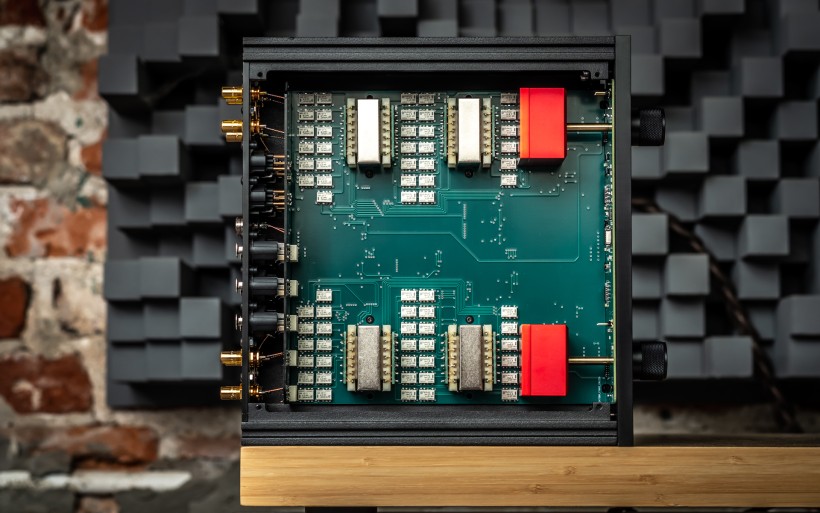 Preamps with two knobs usually have one as the input selector and the other for volume control. Knurled rotaries on the ARP’s CNC-milled aluminium forehead separately regulate volume for each channel. They rotate endlessly, have a nice feel to them and are a pleasure to use. The white dot matrix screen shows the currently selected input and left/right attenuation level. The ‘SOURCE’ pushbutton just below cycles through inputs, ‘STBY’ engages the standby mode and ‘DUALMONO’ de/couples knobs, so that we can adjust volume for the left and right channel either at the same time or individually. Then it doesn’t matter which rotary we use. A dot visible near the active input lets us know when they work independently. While it’s a subjective thing, the leather insert on the front panel contributes to the ARP’s already unusual personality and gives off posh vibes. Personally I fancy the view and also applaud Arek for expertly incorporating the leather part into the front panel. I’m not sure whether today’s finned cheeks were cast from steel or not, but they sure look like it. Ditto the underside atop four semi-spherical rubber pucks. The top is aluminium and so is the rear panel that packs a 5-pin power inlet between four outputs (2x RCA + 2x XLR) and five inputs (3x XLR + 2x RCA). Should you wonder about the “Made in Spain” sign, that’s where Arek and his family live.
Preamps with two knobs usually have one as the input selector and the other for volume control. Knurled rotaries on the ARP’s CNC-milled aluminium forehead separately regulate volume for each channel. They rotate endlessly, have a nice feel to them and are a pleasure to use. The white dot matrix screen shows the currently selected input and left/right attenuation level. The ‘SOURCE’ pushbutton just below cycles through inputs, ‘STBY’ engages the standby mode and ‘DUALMONO’ de/couples knobs, so that we can adjust volume for the left and right channel either at the same time or individually. Then it doesn’t matter which rotary we use. A dot visible near the active input lets us know when they work independently. While it’s a subjective thing, the leather insert on the front panel contributes to the ARP’s already unusual personality and gives off posh vibes. Personally I fancy the view and also applaud Arek for expertly incorporating the leather part into the front panel. I’m not sure whether today’s finned cheeks were cast from steel or not, but they sure look like it. Ditto the underside atop four semi-spherical rubber pucks. The top is aluminium and so is the rear panel that packs a 5-pin power inlet between four outputs (2x RCA + 2x XLR) and five inputs (3x XLR + 2x RCA). Should you wonder about the “Made in Spain” sign, that’s where Arek and his family live.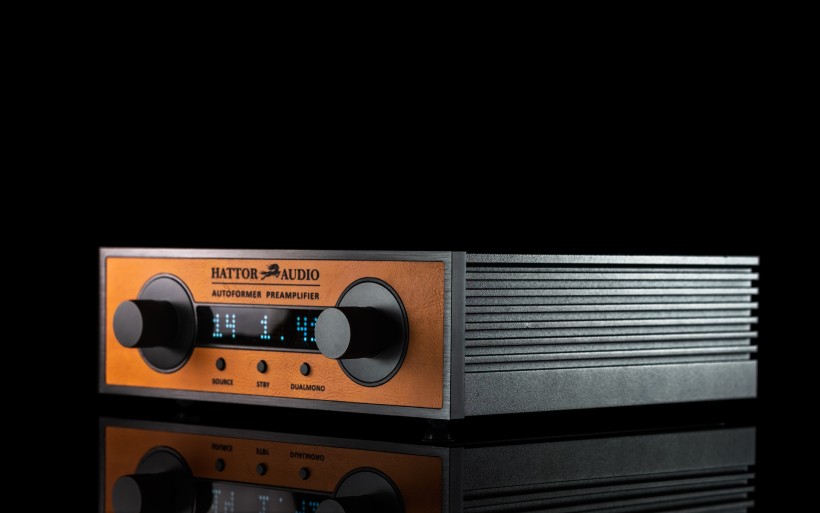 All in all, Hattor Audio ARP is very well put together, offers just what we’d expect from such a product and is instantly ready for action upon powering it on. While this isn’t a conventional preamplifier, in practice it very much feels and operates like one. The interface in it needs 5V to make it so. Purist passive preamps designed to work entirely off the grid offer far fewer more crude steps and lack remote control, so two very useful niceties if not necessary utilities. Meanwhile, the ARP’s sleek aluminium remote wand powers it on/off, cycles through inputs, mutes playback, dims display and regulates volume, so does pretty much everything we may possibly need. Last time I checked, user convenience was important. Two boxes that form this report’s set may say nay to that. Luckily the linear PSU for the ARP is very compact and not fussy about space at all. Some would also agree that a toroid-based power supply in its own chassis adds the extra points to the product’s already elevated status. The presence of a such PSU instead of a standard-issue 5V critter is mighty impressive, its infusion with leather on the front just to match the main unit quite mental. All the extras poured into the ARP suggest a major standout for the coin that was put together with utmost care. The view under the bonnet reflects that, too. Each knob connects to the optical shaft encoder inside its own excellent aluminium compartment. That’s Khozmo stuff right there. Two autoformers per channel, so one for each phase, feature Supermalloy cores (80% nickel content) and are surrounded by an army of hermetically sealed Omron relays with silver contacts and guaranteed lifespan of 50 milion cycles. While these parts also need power to upkeep their status, only their contacts are in the signal path. With all that out of the way, we can finally move onto sonics and ideally with our seat belt strapped on.
All in all, Hattor Audio ARP is very well put together, offers just what we’d expect from such a product and is instantly ready for action upon powering it on. While this isn’t a conventional preamplifier, in practice it very much feels and operates like one. The interface in it needs 5V to make it so. Purist passive preamps designed to work entirely off the grid offer far fewer more crude steps and lack remote control, so two very useful niceties if not necessary utilities. Meanwhile, the ARP’s sleek aluminium remote wand powers it on/off, cycles through inputs, mutes playback, dims display and regulates volume, so does pretty much everything we may possibly need. Last time I checked, user convenience was important. Two boxes that form this report’s set may say nay to that. Luckily the linear PSU for the ARP is very compact and not fussy about space at all. Some would also agree that a toroid-based power supply in its own chassis adds the extra points to the product’s already elevated status. The presence of a such PSU instead of a standard-issue 5V critter is mighty impressive, its infusion with leather on the front just to match the main unit quite mental. All the extras poured into the ARP suggest a major standout for the coin that was put together with utmost care. The view under the bonnet reflects that, too. Each knob connects to the optical shaft encoder inside its own excellent aluminium compartment. That’s Khozmo stuff right there. Two autoformers per channel, so one for each phase, feature Supermalloy cores (80% nickel content) and are surrounded by an army of hermetically sealed Omron relays with silver contacts and guaranteed lifespan of 50 milion cycles. While these parts also need power to upkeep their status, only their contacts are in the signal path. With all that out of the way, we can finally move onto sonics and ideally with our seat belt strapped on.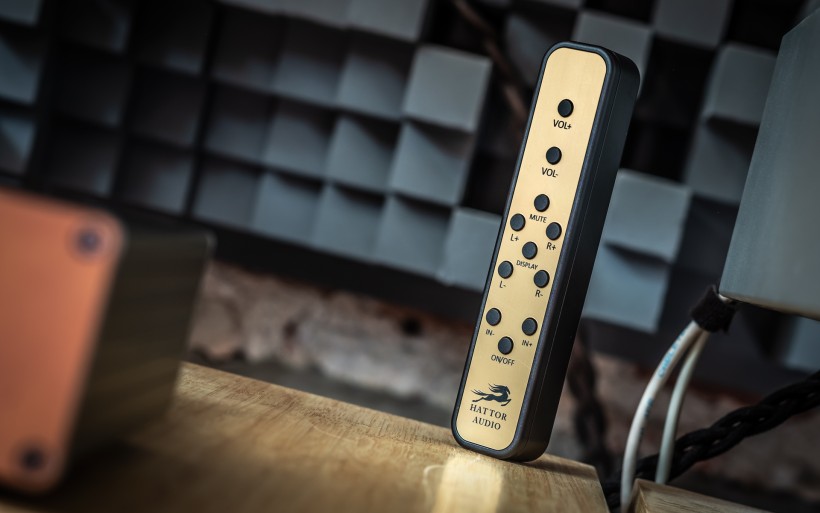 The Innuos Statement Next-Gen passed data to the Horizon360 DAC that had its volume defeated and sent signal to the Trilogy 915R/995R analog end. From there either sound|kaos Vox 3afw monitors or Boenicke W11 SE+ floorstanders took over. The cables used to connect my DAC, pre and monos were XLRs I proudly DIY-ed with LessLoss C-MARC wiring and Furutech bits. In my system, the juncture between the DAC and 995Rs was the ARP’s target habitat, wherein it had to exchange blows with the six times dearer 915R pre that currently retails for €27’950. Should you think this fight was a loss for the Hattor before it even started, it wasn’t. More about that in a bit. Trilogy’s pre is a massive all-around sublime hybrid tank that does a lot for my platform’s sound and ease of use. The manufacturer’s TASlink interface allows it to control twin 995Rs, so that I can remotely power on all three components via one button press, check their tube status, set amps as class A/AB devices on the fly and so on so forth. With the ARP engaged that convenience was no more, but its smaller footprint, significantly lower sticker, audible bass from the earliest (!!!) volume levels and squeaky clean output were the valuable upshots. With the 915R on duty, sensitive Vox speakers reported mild background noise that wasn’t an issue when the music was on. With the ARP however there was dead silence, as if my setup was powered off. This outcome was expected.
The Innuos Statement Next-Gen passed data to the Horizon360 DAC that had its volume defeated and sent signal to the Trilogy 915R/995R analog end. From there either sound|kaos Vox 3afw monitors or Boenicke W11 SE+ floorstanders took over. The cables used to connect my DAC, pre and monos were XLRs I proudly DIY-ed with LessLoss C-MARC wiring and Furutech bits. In my system, the juncture between the DAC and 995Rs was the ARP’s target habitat, wherein it had to exchange blows with the six times dearer 915R pre that currently retails for €27’950. Should you think this fight was a loss for the Hattor before it even started, it wasn’t. More about that in a bit. Trilogy’s pre is a massive all-around sublime hybrid tank that does a lot for my platform’s sound and ease of use. The manufacturer’s TASlink interface allows it to control twin 995Rs, so that I can remotely power on all three components via one button press, check their tube status, set amps as class A/AB devices on the fly and so on so forth. With the ARP engaged that convenience was no more, but its smaller footprint, significantly lower sticker, audible bass from the earliest (!!!) volume levels and squeaky clean output were the valuable upshots. With the 915R on duty, sensitive Vox speakers reported mild background noise that wasn’t an issue when the music was on. With the ARP however there was dead silence, as if my setup was powered off. This outcome was expected.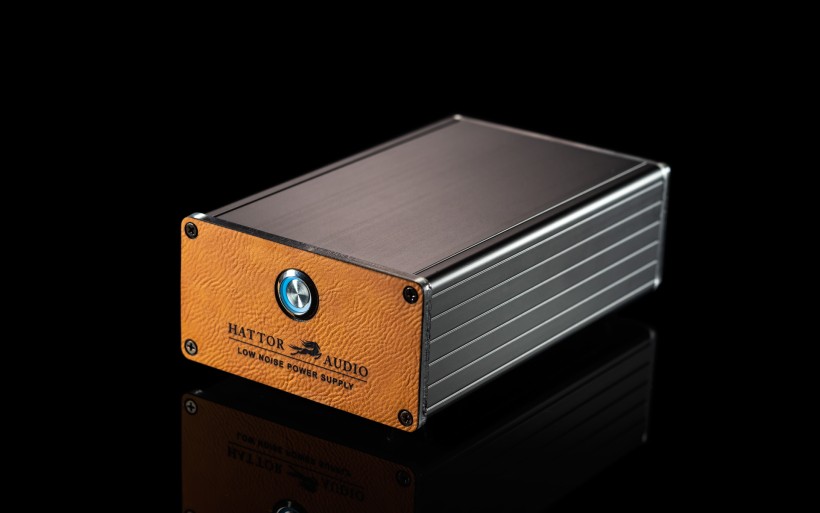 Pál Nagy’s icOn 4PRO that I reviewed four years ago also was extremely silent. The ARP merely confirmed this desirable behavior is typical of passive AVCs. To push the quiet envelope even further and entirely eliminate regulatory noise, the former engineer used in his machine ultra-fast Vishay Fets as autoformer tap selectors. The ARP’s relays clicked mildly, but that was hardly a con. Moving on, the transparency baked into passive preamps is one of the things I could easily put to the test. Connecting such a device into the existing system and tracking any audible changes is all it takes to do so. My platform welcomed the idea. The signal went from the Horizon360 DAC into the 915R pre and from there to the ARP with its volume set at 56/61 to effectively make it a buffer device that connected to the British monos. I had a listen to the system as outlined. Then the ARP was disengaged and I listened again. Rinse and repeat some half a dozen times. Done. The result in both use case scenarios was very much alike, in the sense that my ears didn’t register any changes worth holding on to. That also was as foretold. The icOn 4PRO that I used in the same exact way in 2021 was:“… just an invisible bystander that didn’t break, fix or change anything specific audibly enough to consider its presence any meaningful, or quite frankly noticeable. Even if it did something, my senses simply failed to grasp it. This was telling. A major component’s ability to just be a part of a system without influencing its sound in any noticeable way is the very definition of transparency. I expected the icOn used as a buffer to at the very least gently steer my platform’s voicing into a more illuminated skinnier speedier direction. Nothing of the sort had happened.” Simply put, the ARP now proved as invisible as the 4PRO four springs ago. One such elusive design could’ve been a lucky coincidence. Two marked a firm pattern. On transparency passive AVCs are second to none, that’s the takeaway. The ARP also made a point that their kind is ace elsewhere.
Pál Nagy’s icOn 4PRO that I reviewed four years ago also was extremely silent. The ARP merely confirmed this desirable behavior is typical of passive AVCs. To push the quiet envelope even further and entirely eliminate regulatory noise, the former engineer used in his machine ultra-fast Vishay Fets as autoformer tap selectors. The ARP’s relays clicked mildly, but that was hardly a con. Moving on, the transparency baked into passive preamps is one of the things I could easily put to the test. Connecting such a device into the existing system and tracking any audible changes is all it takes to do so. My platform welcomed the idea. The signal went from the Horizon360 DAC into the 915R pre and from there to the ARP with its volume set at 56/61 to effectively make it a buffer device that connected to the British monos. I had a listen to the system as outlined. Then the ARP was disengaged and I listened again. Rinse and repeat some half a dozen times. Done. The result in both use case scenarios was very much alike, in the sense that my ears didn’t register any changes worth holding on to. That also was as foretold. The icOn 4PRO that I used in the same exact way in 2021 was:“… just an invisible bystander that didn’t break, fix or change anything specific audibly enough to consider its presence any meaningful, or quite frankly noticeable. Even if it did something, my senses simply failed to grasp it. This was telling. A major component’s ability to just be a part of a system without influencing its sound in any noticeable way is the very definition of transparency. I expected the icOn used as a buffer to at the very least gently steer my platform’s voicing into a more illuminated skinnier speedier direction. Nothing of the sort had happened.” Simply put, the ARP now proved as invisible as the 4PRO four springs ago. One such elusive design could’ve been a lucky coincidence. Two marked a firm pattern. On transparency passive AVCs are second to none, that’s the takeaway. The ARP also made a point that their kind is ace elsewhere.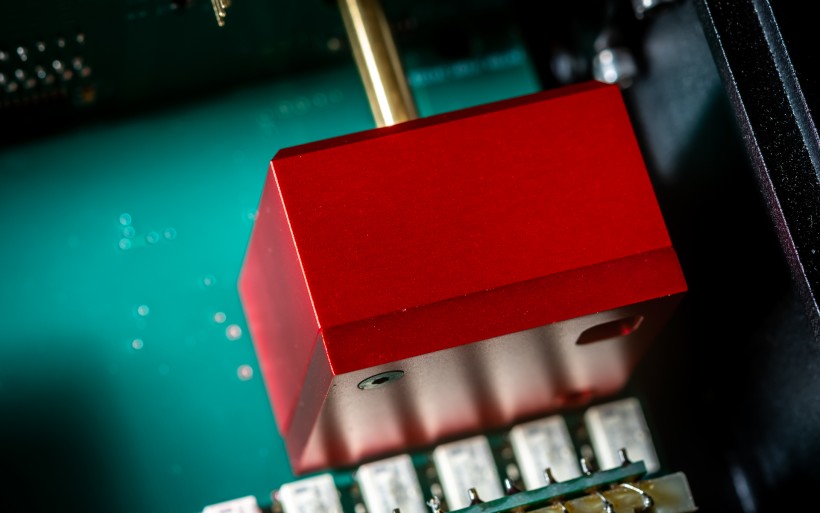 Trilogy 915R contributes to my system’s sound by making it spatially large, quick, impactful, tonally packed, breathing and tangible. As such it nicely complements the two 995Rs and in fact boosts their performance by a significant margin. Without my previous exposure to the passive AVC designs, I’d be convinced that the 915R would run circles around the ARP. Without this intel, I would expect the latter to be drier, leaner and inferior. The prohibitively large price gap between them would factor in and have me subconsciously biased, too. Four years later it doesn’t. Reviewer smarts have nothing to do with that, experience does. Mine still reminds me that the icOn 4PRO loaner was a monster preamp, period. By that I mean a visually inconspicuous financially sane box you can safely put up against any classic pre on the market no matter how dear or big, and smile knowing that it’ll firmly hold its ground. The ARP proved one such a nifty little devil with large pointy horns, too. With volume set at 30/61 it already got me stout SPL. While it was spatially more specific, sunnier, somewhat leaner and tonally a touch cooler than the 915R, it staged like mad, was as smooth as they come and still generous on color. It had all the fundamentals thoroughly in check. Graininess, fragility, nervousness and paleness weren’t invited.
Trilogy 915R contributes to my system’s sound by making it spatially large, quick, impactful, tonally packed, breathing and tangible. As such it nicely complements the two 995Rs and in fact boosts their performance by a significant margin. Without my previous exposure to the passive AVC designs, I’d be convinced that the 915R would run circles around the ARP. Without this intel, I would expect the latter to be drier, leaner and inferior. The prohibitively large price gap between them would factor in and have me subconsciously biased, too. Four years later it doesn’t. Reviewer smarts have nothing to do with that, experience does. Mine still reminds me that the icOn 4PRO loaner was a monster preamp, period. By that I mean a visually inconspicuous financially sane box you can safely put up against any classic pre on the market no matter how dear or big, and smile knowing that it’ll firmly hold its ground. The ARP proved one such a nifty little devil with large pointy horns, too. With volume set at 30/61 it already got me stout SPL. While it was spatially more specific, sunnier, somewhat leaner and tonally a touch cooler than the 915R, it staged like mad, was as smooth as they come and still generous on color. It had all the fundamentals thoroughly in check. Graininess, fragility, nervousness and paleness weren’t invited. 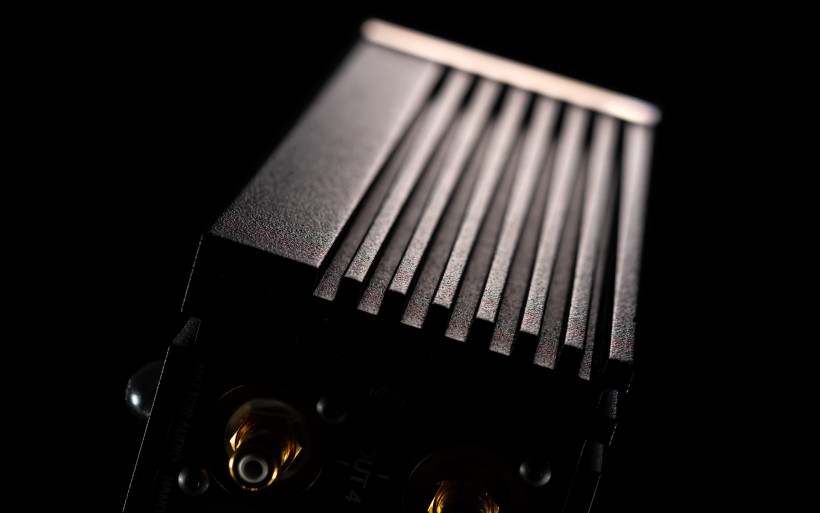 I didn’t have icOn 4PRO to compare it to the ARP. If I did, most likely I would have a really hard time telling which one’s which. About the former I wrote that: “…in my system, it quickly revealed its gearing for top-shelf imaging specificity, layering complexity, lucidity, articulation, immediacy, quickness and freshness. These traits translated into copious amounts of air around virtual sound sources, their utmost precisely sketched outlines and direct overall delivery. As naturally centered around quick reflexes and insight as it is, this aroma often comes at a price paid in decreased moisture, muscularity, thickness, smoothness and bass reach. The icOn however felt highly coherent, balanced and pleasantly organic. Nothing about it sound struck me as gritty, sharp, itchy or abnormally zealous. My system with it engaged neither sounded thin, nor lifeless, matte, hollow, dehydrated or crippled in any way in particular. The icOn’s skill set and avoidance of downsides typical for its zesty voicing spelled out high-tiered completeness and admirable seasoning certainly way above its asking price.” Simply replace icOn with ARP and that’s how the latter went about its business in my listening room. It was supposed to. Passive AVCs are very specific in what they do and how.
I didn’t have icOn 4PRO to compare it to the ARP. If I did, most likely I would have a really hard time telling which one’s which. About the former I wrote that: “…in my system, it quickly revealed its gearing for top-shelf imaging specificity, layering complexity, lucidity, articulation, immediacy, quickness and freshness. These traits translated into copious amounts of air around virtual sound sources, their utmost precisely sketched outlines and direct overall delivery. As naturally centered around quick reflexes and insight as it is, this aroma often comes at a price paid in decreased moisture, muscularity, thickness, smoothness and bass reach. The icOn however felt highly coherent, balanced and pleasantly organic. Nothing about it sound struck me as gritty, sharp, itchy or abnormally zealous. My system with it engaged neither sounded thin, nor lifeless, matte, hollow, dehydrated or crippled in any way in particular. The icOn’s skill set and avoidance of downsides typical for its zesty voicing spelled out high-tiered completeness and admirable seasoning certainly way above its asking price.” Simply replace icOn with ARP and that’s how the latter went about its business in my listening room. It was supposed to. Passive AVCs are very specific in what they do and how. 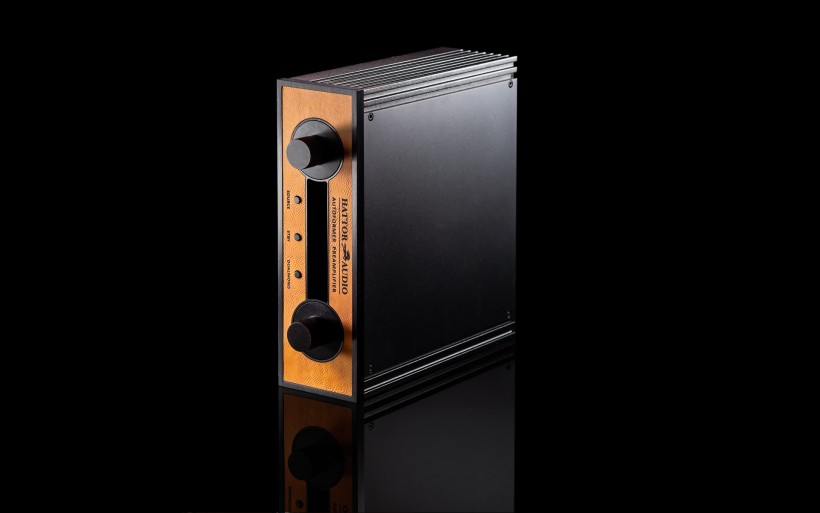 As amazing from the get-go as it was, the ARP grew on me over the next days. The more it clashed with the 915R, the more obvious it became that my daily driver was destined to at best match the competitor, let alone surpassing it. As oppositely tuned as both these machines were, on sheer sonic competence I considered them equals. Most regular shoppers who forked out nearly €30K on a preamp would find this result a hard pill to swallow. I didn’t mind knowing that the performance associated with AVCs goes above money. It really does, the ARP merely stressed that point. The 915R isn’t particularly romantic, calm, warm, cuddly or dark per se. Just next to the Hattor it was to an extent. My system with this tiny box on board scored higher notes on resolution, openness, directness, agility, radiance, tighter bass control and sensibly lower reach. Higher energy, excitement and intensity followed. By contrast, the 915R sounded more voluptuous and liberal on outline jobs, meatier, spatially somewhat diffused, relaxed and picturesque. Although the ARP was leaner, more meticulous, shinier, utmost elastic and into spring not autumn hues, it didn’t skip classes on wide color gamut and textures that make music vivid and joyful. In spite of its predominantly quicksilvery sporty core neither it felt artificial, nor it left me with craves for anything specific related to tone and substance. If it were an amp, it would be a Firstwatt SIT5 or Enleum AMP-23R.
As amazing from the get-go as it was, the ARP grew on me over the next days. The more it clashed with the 915R, the more obvious it became that my daily driver was destined to at best match the competitor, let alone surpassing it. As oppositely tuned as both these machines were, on sheer sonic competence I considered them equals. Most regular shoppers who forked out nearly €30K on a preamp would find this result a hard pill to swallow. I didn’t mind knowing that the performance associated with AVCs goes above money. It really does, the ARP merely stressed that point. The 915R isn’t particularly romantic, calm, warm, cuddly or dark per se. Just next to the Hattor it was to an extent. My system with this tiny box on board scored higher notes on resolution, openness, directness, agility, radiance, tighter bass control and sensibly lower reach. Higher energy, excitement and intensity followed. By contrast, the 915R sounded more voluptuous and liberal on outline jobs, meatier, spatially somewhat diffused, relaxed and picturesque. Although the ARP was leaner, more meticulous, shinier, utmost elastic and into spring not autumn hues, it didn’t skip classes on wide color gamut and textures that make music vivid and joyful. In spite of its predominantly quicksilvery sporty core neither it felt artificial, nor it left me with craves for anything specific related to tone and substance. If it were an amp, it would be a Firstwatt SIT5 or Enleum AMP-23R.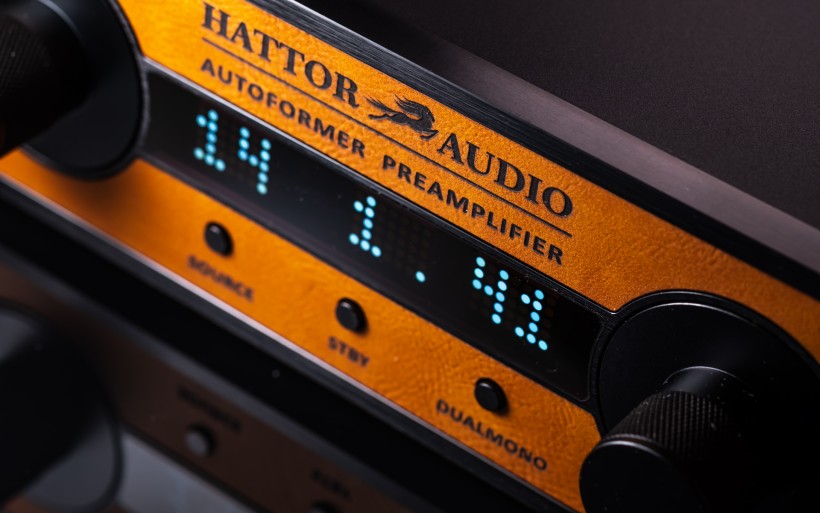 I can’t say that I stopped liking the 915R after its fight with the ARP. The Brit was audibly more gifted on portraying vocal and instrumental shapes as more seductive lifelike beings. The newcomer was solid in this regard, but not quite as good. This is why I think that most listeners would consider the 915R/995R set as sprinkled with the extra elegance and more inviting in the process. On the other hand, each time when the ARP was on, the impression was as if the previously present veil, residual drag and spatial blur completely evaporated, while dynamic span had become wider. That was possible to map only by subtraction. The noticeable difference on that front marked my personal reason why the ARP was quite unpudownable. The sensation with it engaged was comparable to listening to a crossoverless full-ranger inside a voluminous enclosure after spending some time with nice albeit regularly vented speakers. On immediacy, insight, control, quickness, clarity and muscle-to-fat ratio, well, they’re not the same. Just so we’re clear, the ARP followed the widebander protocol.
I can’t say that I stopped liking the 915R after its fight with the ARP. The Brit was audibly more gifted on portraying vocal and instrumental shapes as more seductive lifelike beings. The newcomer was solid in this regard, but not quite as good. This is why I think that most listeners would consider the 915R/995R set as sprinkled with the extra elegance and more inviting in the process. On the other hand, each time when the ARP was on, the impression was as if the previously present veil, residual drag and spatial blur completely evaporated, while dynamic span had become wider. That was possible to map only by subtraction. The noticeable difference on that front marked my personal reason why the ARP was quite unpudownable. The sensation with it engaged was comparable to listening to a crossoverless full-ranger inside a voluminous enclosure after spending some time with nice albeit regularly vented speakers. On immediacy, insight, control, quickness, clarity and muscle-to-fat ratio, well, they’re not the same. Just so we’re clear, the ARP followed the widebander protocol.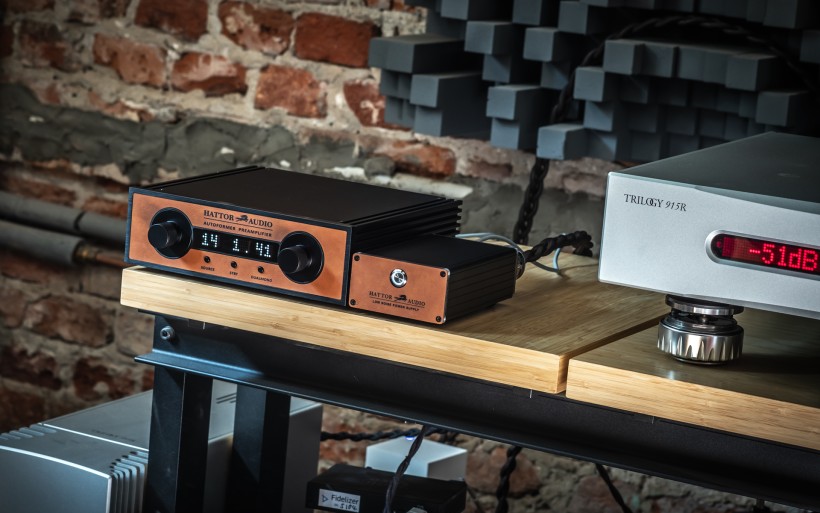 After reviewing the icOn in the past and ARP just now, it’s fitting to name their AVC breed as potent accelerators and blur banishers, among many other things they’re capable of. All things considered, it’s quite spectacular what a piece of wire used for volume control can do. It really is. The question remains whether a system can get by without all the heft and tonal mass it apparently gets from active preamps busy with resistive attenuators. Mine taps into these traits courtesy of several components in it, so the terrific outcome as explained followed and was possible in the first place. I can’t however vouch for platforms primed just as the ARP. Perhaps in such an environment its input would’ve been too much of the same thing. Odds are that such systems benefit from conventional preamps as means that keep sound balanced. Come to think of it, perhaps the ARP doesn’t have a sound of its own? Perhaps letting us know how our systems fare without the extra resistance and active circuitry in it is all this compact AVC affair actually does? And the noticeable performance hike that in many scenarios will follow is just the byproduct of that? Beats me, but ARP’s a spectacular device either way. Let’s wrap.
After reviewing the icOn in the past and ARP just now, it’s fitting to name their AVC breed as potent accelerators and blur banishers, among many other things they’re capable of. All things considered, it’s quite spectacular what a piece of wire used for volume control can do. It really is. The question remains whether a system can get by without all the heft and tonal mass it apparently gets from active preamps busy with resistive attenuators. Mine taps into these traits courtesy of several components in it, so the terrific outcome as explained followed and was possible in the first place. I can’t however vouch for platforms primed just as the ARP. Perhaps in such an environment its input would’ve been too much of the same thing. Odds are that such systems benefit from conventional preamps as means that keep sound balanced. Come to think of it, perhaps the ARP doesn’t have a sound of its own? Perhaps letting us know how our systems fare without the extra resistance and active circuitry in it is all this compact AVC affair actually does? And the noticeable performance hike that in many scenarios will follow is just the byproduct of that? Beats me, but ARP’s a spectacular device either way. Let’s wrap.
My fondness for passive AVC designs didn’t come out of nowhere. The petite cost-effective icOn 4PRO that I’ve reviewed in the past not only turned out wickedly good, but also one very dangerous competitor to conventional preamps. As such, this one-off wonder got stuck in the back of my head for years to come. Now that itch is gone, courtesy of Hattor Audio ARP that fits the same kosher profile on all fronts. While it feels and behaves like a regular preamp, it is quieter than most and brilliant on low SPL. It is priced more than fairly given how sonically accomplished, visually pleasing and nicely put together it is. It also may be the most affordable commercial AVC design on the market. Asking for more would be a crime. All things considered, auditioning this all around impressive stunner prior to anything else no matter how fancy is my sincere advice. Lastly, a tip of the hat to Arek Kallas for landing it and pursuing passive AVCs in the first place. It was well worth the effort!
Associated Equipment:
- Amplifier: Trilogy 995R, FirstWatt F7, Enleum AMP-23R
- DAC: LampizatOr Horizon360 (Stradi 5U4G + Psvane Art TIII 4x KT88 / 2x 6SN7)
- Speakers: Boenicke Audio W11 SE+, sound|kaos Vox 3afw
- Transport: Innuos Statement, fidata HFAS1-S10U
- Preamplifier: Trilogy 915R, Thöress DFP
- Speaker cables: Boenicke Audio S3, LessLoss C-MARC
- Headphones: HifiMan Susvara
- Speaker signal conditioning: LessLoss Firewall for Loudspeakers, Boenicke ComDev
- Anti-vibration conditioning: 6x Carbide Base Diamond (under streamer), 6x Carbide Base Micro Diamond with TwinDamp inserts and spikes (under DAC and pre), Vibra 68 (under speakers), 12x LessLoss Giant Steps (under streamer, DAC and pre)
- Interconnects: LessLoss Entropic Process C-MARC, Boenicke Audio IC3 CG
- Power components: Gigawatt PC-3 SE EVO+/LC-3 EVO, LessLoss C-MARC, LessLoss Entropic C-MARC, LessLoss Stellar C-MARC, LessLoss Power Distributor into Boenicke Audio Power Gate, ISOL-8 Prometheus
- USB components: AudioPhonique Desire USB
- Rack: Franc Audio Accesories Wood Block Rack 1+3
- Network: Fidelizer EtherStream, Linksys WRT160N
- Music: NativeDSD
Retail prices of reviewed components in EU (incl. VAT):
- Hattor Audio ARP (copper AVC) single-ended/balanced : €2’500/3’500
- Hattor Audio ARP (silver AVC) single-ended/balanced : €4’500/6’900
Manufacturer: Hattor Audio


